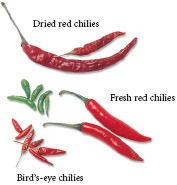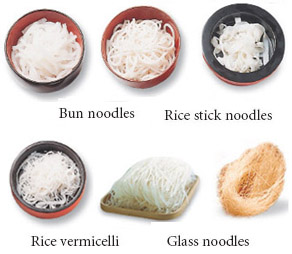Basic Vietnamese Ingredients

Basil is often used as a seasoning and garnish in Vietnamese cooking. Several types of basil are used; the most common is Asian basil (known as horapa in Thailand), which is similar to European sweet basil. It is used liberally as a seasoning and sprigs are often added to platters of fresh, raw vegetables. Similar, yet paler in color, and with a distinctive lemony fragrance, lemon basil is used in soups and salads. Holy basil has distinctive purple-reddish leaves and a mint-like zesty flavor and is used for stir-fries. Lemon basil and holy basil are not widely found outside Asia. Basil doesn't store well, so buy it just before you intend to use it. European sweet basil can be used as a substitute for all varieties. Basil has a strong flavor, so don't use more than the recipe states.

Chilies have become an essential culinary item in almost every Asian country. Many different varieties are used. The Asian finger-length red chili is moderately hot. Dried red chilies of this variety are ground to make chili flakes or ground red pepper. Tiny bird's-eye chilies are extremely hot. They are also available dried. The seeds are usually removed when chilies are sliced or minced. Coconut cream and coconut milk are used in many Vietnamese desserts. While freshly pressed milk has more flavor, coconut cream and milk are now widely sold in cans and packets that are quick, convenient and tasty. You can add 1 cup of water to 1 cup of canned or packet coconut cream to obtain thick coconut milk, and add 2 cups of water to 1 cup of coconut cream to obtain thin coconut milk. Canned or packet coconut cream or milk comes in varying consistencies depending on the brand, and you will need to try them out and adjust the thickness by adding water as needed. Fresh coconut cream is made by grating the flesh of 1 coconut (this will yield about 4 cups of grated coconut flesh), adding ½ cup water, kneading a few times, then straining with your fist, or with a muslin cloth or cheesecloth. This should yield about ½ cup of coconut cream. Thick coconut milk is obtained by the same method, but the water is doubled to 1 cup and 1 coconut will yield about 1 cup of thick coconut milk. Thin coconut milk is obtained by adding 1 cup of water to the already pressed coconut flesh a second time and straining again, and this should yield 1 cup of thin coconut milk. You may also obtain thin coconut milk by diluting the thick coconut milk with water.

Coriander leaves or cilantro are the leaves of the coriander plant and are often referred to as Chinese parsley. In Vietnam, coriander leaves are used almost exclusively as a garnish. Fresh coriander leaves should keep for 5 to 6 days in the refrigerator if you wash and dry the leaves, and store them in a plastic bag. Italian parsley can be used as a substitute, although the flavor is not the same.
Curry powder is a spice blend made from various combinations of ground spices that generally include cumin, coriander seeds, chilies, turmeric, ginger, cinnamon and cloves. Different spice combinations vary in color and flavor. Look for curry powder in the spice section of supermarkets.

Dried rice paper wrappers are paper-thin wrappers made from a batter of rice flour, water and salt, that are steamed and dried in the sun on bamboo racks, which leaves a crosshatched imprint on the wrappers. Used to wrap a wide variety of spring rolls, dried rice paper wrappers must be moistened before using. Available in many Asian food markets, they will keep for many months if stored in a cool dark place.
Fish sauce is the ubiquitous condiment used in almost every Vietnamese dish, just as salt or soy sauce are used in other cuisines. Made from salted, fermented fish or shrimp, it has a very pungent, salty flavor in its pure form. Fish sauce is often combined with other ingredients such as sugar, garlic and lime juice to make the various dipping sauces known as nuoc mam cham. Use sparingly and look for a quality brand for a better flavor. Refrigerate after opening.
Five spice powder is a blend of fragrant cinnamon, star anise, cloves, fennel seeds and Sichuan peppercorns. This reddish-brown powder is popular as a seasoning in Chinese cuisine and some Thai and Vietnamese dishes. Packets of five spice powder are available in Asian food stores. It is generally used in small amounts as it is quite strong. To keep fresh as long as possible, store five spice powder in the refrigerator.

Galangal is a fragrant root belonging to the ginger family that is used in much the same way as ginger. Known as kha in Thailand, laos in Indonesia and lengkuas in Malaysia and Singapore, it adds a distinctive fragrance and flavor to many dishes. Though available dried or as a powder, try to purchase the fresh root, which has a much richer flavor. Fresh galangal should be peeled before using. The young, pinkish galangal is the most tender and imparts the best flavor. Fresh galangal will keep for several months if wrapped in plastic and stored in the freezer.
Hoisin sauce is a sweet, reddish-brown sauce made from soy beans, garlic, peppers and various spices. Commonly used as a table condiment and flavoring in meat, poultry and shellfish dishes, this Chinese sauce is available in bottles and cans in Asian food stores. Canned hoisin should be stored in a non-metal airtight container. Bottled hoisin will keep indefinitely when refrigerated.
Lemongrass, also known as citronella, is an intensely fragrant stalk used to impart a lemony flavor to many dishes. The thick lower part of the stem nearest the roots is the edible portion. Discard the outer leaves until you reach the inner core, which should be moist and tender. When using the stalk, bruise it before cooking and remove it from the dish after cooking and before serving. Lemongrass is readily available fresh or frozen in well-stocked supermarkets.
Mint leaves, one of the most common Vietnamese herbs, are indispensable in salads. Mint grown in Southeast Asia has a very intense flavor, similar to spearmint, although regular mint leaves may also be used.
Polygonum or Vietnamese mint (rau ram) is an important Vietnamese herb—known as laksa leaf in Singapore, Malaysia and Australia. It is served with nearly every meal in Vietnam. Highly aromatic, it has a pink stem and pointed, purplish leaves, and is commonly used as a garnish. A combination of mint and coriander leaves (cilantro) makes an acceptable substitute.

Noodles made from rice, both fresh and dried, are widely used in Vietnamese cooking. White rice stick noodles (banh pho) are used in Vietnam's classic breakfast dish, pho. Bun noodles (fresh or dried) are thick, round rice noodles that double their size and turn very white when cooked. Fine rice vermicelli (banh hoi) are similar to bun noodles, but thinner.Glass or cellophane noodles (mien in the north and bun tao in the south) are dried, translucent noodles made from mung bean starch, which are reconstituted by pouring hot water over them.

Pomelo, the Vietnamese equivalent of grapefruit, is drier and sweeter than the latter, and has a much thicker and tougher rind. It is eaten dipped in a chili mix, or crumbled and served in salads. It is increasingly available in the West. Grapefruit is a good substitute.
Rice flour is made from uncooked rice grains that are ground to a powder. It is used mainly in desserts. Fresh rice flour may be made by soaking rice grains overnight and then grinding it slowly in a blender. Dried rice flour is sold in packets in Asian stores.
Rice vinegar is mild and faintly fragrant, and is the preferred vinegar throughout Southeast Asia. Inexpensive brands from China are readily available in the West (as well as in Southeast Asia). If you buy a Japanese rice vinegar, make sure you do not buy "sushi vinegar" as this has sweet rice wine, sugar and salt added. If you cannot obtain rice vinegar, use distilled white vinegar and reduce the quantity by about a third.
Rice wine is fermented from freshly steamed rice and has a relatively low alcoholic content. Widely used in Asian cooking, it is readily available in bottles in Asian markets. Japanese sake or dry sherry may be used as a substitute.
Star anise is a star-shaped, eight-pointed pod from an evergreen tree grown in northern Vietnam. It has the pungent flavor of aniseed or licorice. Used most often in soups (pho, in particular) or other recipes requiring long simmering, star anise is available whole or ground to a powder. If used whole, remove before serving.
Tamarind is a large, brown tree pod with a soft, sour pulp and hard, black seeds inside. Tamarind pulp is rich in vitamin C and has a tangy, acidic taste. It is used as a souring agent throughout the world. It can be bought fresh, dried, or in pulp form, and the pulp is commonly sold in compressed blocks, with the seeds removed. To make tamarind juice, mix 1 tablespoon of the dried tamarind pulp with 2 tablespoons of warm water, then mash well and strain to remove the seeds and fibers.
Turmeric is a bright yellow-orange root from the same family as ginger and galangal, with a more subtle flavor. It is often used in curries and as a coloring agent.
Wild betel leaves are the spicy and highly nutritious leaves of a vine related to the black pepper plant. In Vietnam, the large, round and crinkled leaf is used as a leafy green in soups, as an outer wrapping for spring rolls and beef, and as part of the standard table garnish. Grape leaves are an acceptable substitute.
Wood ear fungus is a favorite ingredient in Vietnamese and Chinese cooking. Having very little flavor, it is added to dishes for its crunchy texture and to make a fine filling. It is sold both fresh and dried. Soak dried wood ear fungus in water until soft before using. Wash well and discard any hard patch that may be growing in the center of the mature fungus.






